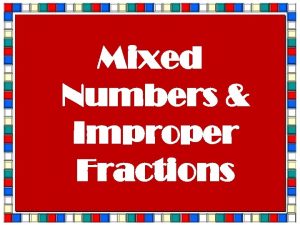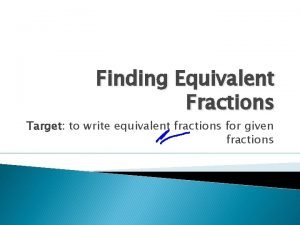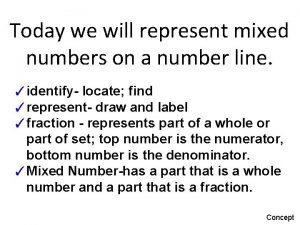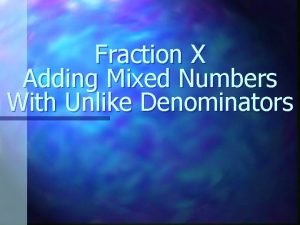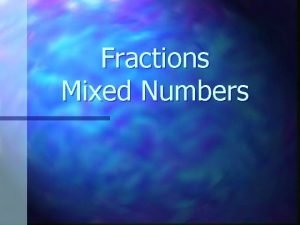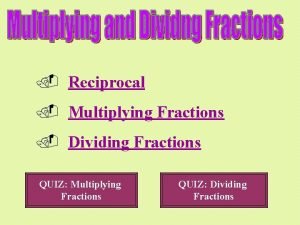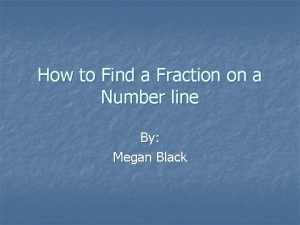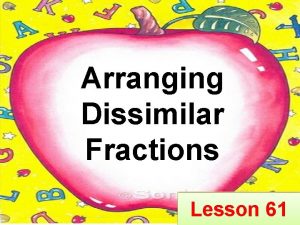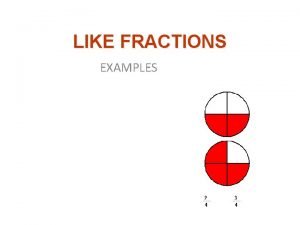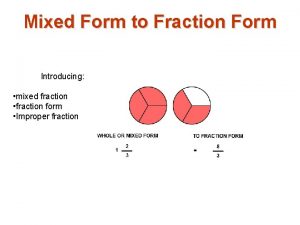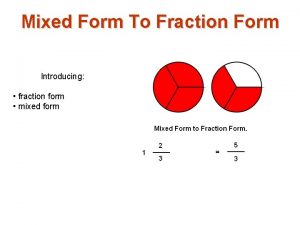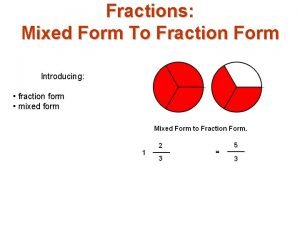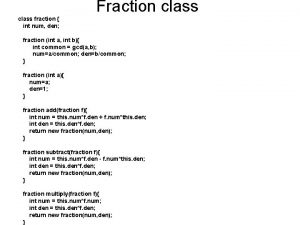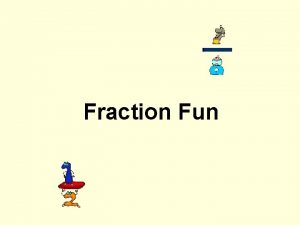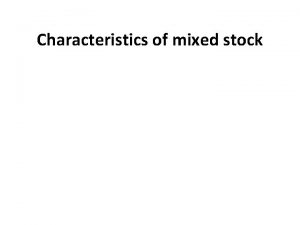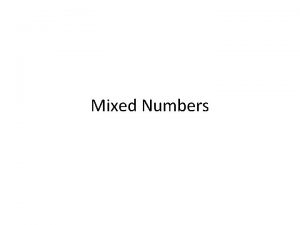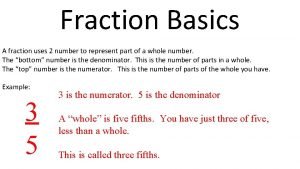Fraction Form to Mixed Form Introducing fraction form














- Slides: 14

Fraction Form to Mixed Form Introducing: • fraction form • mixed form • improper • a/ form, b ≠ 0 b

Fraction Form to Mixed Form 1 This picture shows the fraction 3/4. The circle is divided into 4 equal parts and 3 of the parts are selected.

Fraction Form to Mixed Form 2 Increasing the numerator by one gives the fraction 4/4. The picture shows that the numerator and denominator are the same. All parts of the circle are selected. This gives us a whole number of 1 since the complete unit is selected. You can think of the bar between the numerator and the denominator as a division bar. So 4 divided by 4 equals 1.

Fraction Form to Mixed Form 3 Increasing the numerator again by one gives the fraction 5/4. The picture shows that the numerator is larger than the denominator. Some texts call a fraction such as this improper, where the numerator is equal to or larger than the denominator.

Fraction Form to Mixed Form 4 You can see by the picture that one complete unit and 1/4 unit are selected. So the fraction 5/4 can be written as 11/4. 5/4 is the fraction form or improper form of the number. A fraction such as 11/4 that has a whole number part and a fraction part is known as a mixed number. The fraction form can also be called the a/b form, providing that you specify that b is not equal to zero.

Fraction Form to Mixed Form 5 This picture shows how 11/4 makes two complete units and 3/4 of another unit. You can see from the picture that we have 4/4 + 3/4 or 1+1+ 3/4 or 2 3/4.

Fraction Form to Mixed Form 6 You can calculate the mixed form of a number from the fraction (a/b) form. Rename 23/6 by dividing the numerator 23 by the denominator 6 as is shown in the example on the right. The quotient 3 is the whole number. The remainder 5 is the numerator and the denominator is the same denominator 6.

Fraction Form to Mixed Form 7 The same amount, 23/ 6, is shown with a number line.

Fraction Form to Mixed Form 8 The amount shown at the arrow can be written as 11/5 or 2 1/5. Notice that 5/ names one unit and that there are two 5/ units. 5 5

Fraction Form to Mixed Form 9 Notice how the fraction 10/5 gives the whole number 2.

Fraction Form to Mixed Form 10

Fraction Form to Mixed Form 11

Fraction Form to Mixed Form 12

Fraction Form to Mixed Form 13
 Mixed fraction to improper fraction
Mixed fraction to improper fraction Mixed fraction form
Mixed fraction form How to write mixed fraction
How to write mixed fraction Improper fraction to mixed number
Improper fraction to mixed number Add mixed numbers with unlike denominators
Add mixed numbers with unlike denominators 19/4 as a mixed number fraction
19/4 as a mixed number fraction 42 divided by 3
42 divided by 3 How do you find a fraction of a number
How do you find a fraction of a number Dissimilar fraction example
Dissimilar fraction example Like fraction and unlike fraction
Like fraction and unlike fraction Phrase signal
Phrase signal Introducing phonetics and phonology answer key
Introducing phonetics and phonology answer key 1941-1882
1941-1882 Introducing a quote sentence starters
Introducing a quote sentence starters How do you write a counterclaim
How do you write a counterclaim
